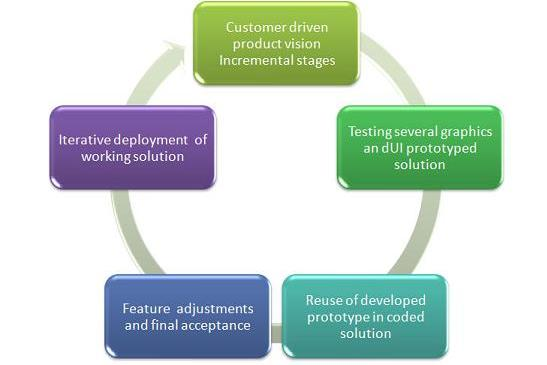PROTOTYPING FOR PRODUCTIVITY
Prototyping Constantly Responses to Solution Needs
A key strength of the Eagle method has been to provide for fast prototyping or the test first code later paradigm which can then efficiently be converted into engineered applications using a variety of programming methods which suit programmers of varying skills. Unlike other prototypes Eagle based solutions are part and parcel of the ultimate solution. Conceptual design and implementation can be part of the solution reducing costs, time and implementation.
 Virtually since inception, Eagle has had the ability to provide dynamic prototyping methods from a geometrical, UI and general programming point of view. We have always had a brilliant solution for prototyping where it is possible to can achieve so much quickly. This prototyping capability has appealed to both engineers and software engineering developers where either one off or early stage development needs can be satisfied. The image shows what can be achive in an hour or so of programming of graphics and UI.
Virtually since inception, Eagle has had the ability to provide dynamic prototyping methods from a geometrical, UI and general programming point of view. We have always had a brilliant solution for prototyping where it is possible to can achieve so much quickly. This prototyping capability has appealed to both engineers and software engineering developers where either one off or early stage development needs can be satisfied. The image shows what can be achive in an hour or so of programming of graphics and UI.
Reuse of Prototype in Final Solution
Prototyping is the cornerstone of XP (Extreme Programming) the method of solution providing that means you don’t need to wait for detailed analysis of the minutiae of the solution in order to enact it, you don’t have to waste valuable time and money, but you initially make a prototype as real proof of concept, create a test harness and then work on the solution. In beauty of the process is you don’t need to envisage a throw away type of prototype, you can simply reuse it as a starting point for the agreed solution. Eagle Framework and Python provide just the framework where this solution driven methodology can be achieved efficiently.
BENEFITS OF ADOPTING PROTOTYPING AS INTEGRAL PART OF THE SOLUTION
- Early functionality testing and implementation
- Provides a process to perfect the requirement
- Provides risk control.
- Documentation focuses on the product not the evolution of the product.
- Provides a formal specification embodied the operating model
- Achieve iterative product rollout gains
- Achieve true virtual solution engineering
- Achieve working initial proof of concept
- Saves costs presenting
- Reduced time and effort defining the solution
- Evolutionary development to achieve result
- Complex domain specific solutions can be managed incrementally
- Continually respond to user needs
- Reduce project specification overload
- Embrace the need for change rather than resist it
- Reuse prototyped code in working solution
- Effectively manage the programmer requirements with user needs
- Provision of exactly what the user actually wants from the solution
- Increased ability to be a market innovator rather than a follower
- More time to focus on what makes your solution unique in a cost effective way
Providing What is Needed and Being Agile to Meet Changing Needs
One of the most important factors in providing a complex domain specific engineered solution is to provide what the eventual user actually wants from the solution. In software development terms this often means at lot of analysis providing a template for development. Invariably the developer depends on the client user to define clearly at the outset what they want from the system however the user is often not quite sure of exactly how to translate that clearly to developers. Only when the solution is in place does the user understand that what is implemented is not quite what was envisaged at the beginning or that the implementation has been partially misunderstood. Only at this point is it realized that the cost of change is preclusive to implementing it and a less than perfect solution has to be adopted or rejected entirely.
Engineering methods tend to try to plan out a large part of the software process in great detail for a long span of time, this works well until things change. Adopting an agile approach such as Extreme Programming XP with a constant cycle of solution testing, communication, simplicity, and feedback means that rather than resist change the developer can embrace it thereby leading to a better overall solution that actually meets its target and can evolve as needs change. In a world where adaptability is vital and client companies constantly have to strive to meet changing market or user needs change is not only necessary but is vital. Agile methods are adaptive rather than predictive. Agile methods are people-oriented rather than process-oriented. The goal of engineering methods is to define a process that will work well whoever happens to be using it.
Eagle V14 CDS Provides Agility and Flexibility
Using Eagle CDS Framework using its powerful prototyping capabilities and ability to engineer the final solution is it is possible provide this continuous cycle of adaptability in a cost effective manner. The open nature of the framework means that the parts which work well in the prototype often can survive reused as the coded solution where some systems critical or externally dependant parts may be plugged in or introduced from external systems.
Eagle's ability to progressively improve the specific solution by prototyping and engineering the process is ideal for customers who not only constantly strive to be market leading innovators but provide valuable return on investment by getting products quickly to the market or deployment in direct response to user needs.

